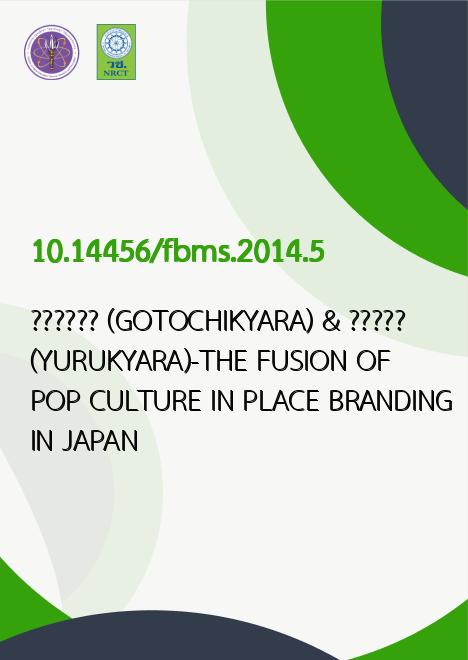
|
?????? (GOTOCHIKYARA) & ????? (YURUKYARA)-THE FUSION OF POP CULTURE IN PLACE BRANDING IN JAPAN |
|---|---|
| รหัสดีโอไอ | |
| Creator | Caroline SL Tan |
| Title | ?????? (GOTOCHIKYARA) & ????? (YURUKYARA)-THE FUSION OF POP CULTURE IN PLACE BRANDING IN JAPAN |
| Publisher | University of the Thai Chamber of Commerce |
| Publication Year | 2557 |
| Journal Title | UTCC International Journal of Business and Economics |
| Journal Vol. | 6 |
| Journal No. | 1 |
| Page no. | 73-90 |
| Keyword | Domestic tourism, Japan, Popular culture, Gotochikyara, Yurukyara |
| URL Website | http://ijbejournal.com/ |
| Website title | ijbejournal |
| ISSN | 1906-5582 (paper) |
| Abstract | This paper examines the prevalence and adoption of popular culture in the establishing of place branding in Japan. While Japan has been famously known as the land of anime, the obsession and attraction towards characters are not merely confined to games, films and comics. The adoption of characters as mascots by various products and services serve as a reminder of the pertinence of such characters in the social landscape. In the efforts of encouraging and further developing domestic tourism, local cities and prefectures have adopted different mascots accordingly (gotochikayara). After the Great East Japan earthquake in 2011, inbound tourism took a plunge however statistics reflect that domestic tourism onlytook a 2% drop in June and July. These mascots are viewed as magnets in drawing a higher rate of domestic tourists as well as generating huge revenues for the specific towns and prefectures. This study begins with the background and explanation of the cute or kawaii culture and the pertinence of characters and mascots. 'The concepts of 'gotochikyara' and yurukyara are also introduced followed by the drivers of travel and destination choices. This study adopts both quantitative and qualitative research approach where young adults (university students) are both interviewed and asked to complete a questionnaire in order to deduce if their travel decisions were made based on the influence of 'yurukyara'. The findings reveal that while yurukyara does play a role, it is less appealing to young adults where travel decisions are not stromgly made based on yurukyara. However, there is still potential for yurukyara to grow stronger in the young adult segment if effective strategies are formulated and executed by the local governments. |